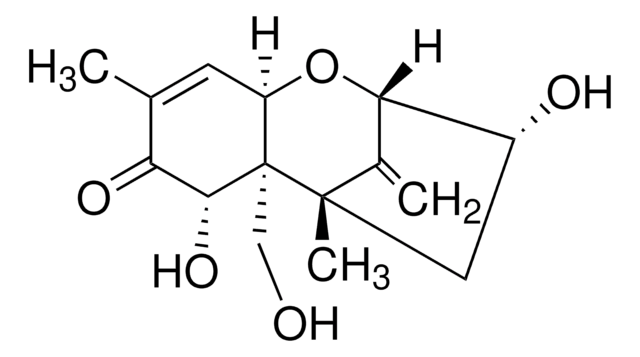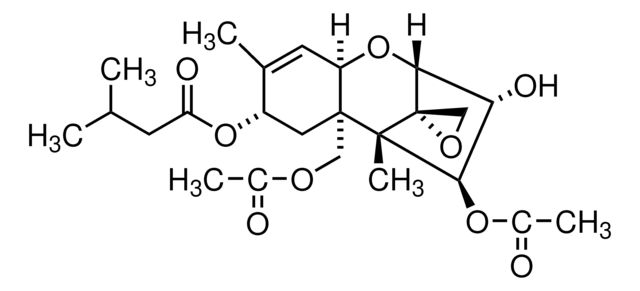D0156
Deoxynivalenol
Synonym(s):
3α,7α,15-Trihydroxy-12,13-epoxytrichothec-9-en-8-one, Vomitoxin
About This Item
Recommended Products
form
powder
Quality Level
storage temp.
2-8°C
SMILES string
[H][C@]12O[C@]3([H])[C@H](O)C[C@@](C)([C@]34CO4)[C@@]1(CO)[C@H](O)C(=O)C(C)=C2
InChI
1S/C15H20O6/c1-7-3-9-14(5-16,11(19)10(7)18)13(2)4-8(17)12(21-9)15(13)6-20-15/h3,8-9,11-12,16-17,19H,4-6H2,1-2H3/t8-,9-,11-,12-,13-,14-,15+/m1/s1
InChI key
LINOMUASTDIRTM-QGRHZQQGSA-N
Looking for similar products? Visit Product Comparison Guide
General description
Application
- as a mycotoxin to induce cytotoxicity in porcine jejunal epithelial cells and study the protective effects of Saccharomyces cerevisiae on the cell viability of host cells.
- to induce toxicity in nude mice to study the effect of probiotics (Lactobacillus rhamnosus GG (LGG) or Lactobacillus acidophilus (LA)) supplementation on host protection
- as a thyroid hormone receptor (TRβ) antagonist in cell-based luciferase reporter gene (CALUX) assay
Biochem/physiol Actions
Signal Word
Danger
Hazard Statements
Precautionary Statements
Hazard Classifications
Acute Tox. 2 Oral
Storage Class Code
6.1A - Combustible acute toxic Cat. 1 and 2 / very toxic hazardous materials
WGK
WGK 3
Flash Point(F)
Not applicable
Flash Point(C)
Not applicable
Personal Protective Equipment
Certificates of Analysis (COA)
Search for Certificates of Analysis (COA) by entering the products Lot/Batch Number. Lot and Batch Numbers can be found on a product’s label following the words ‘Lot’ or ‘Batch’.
Already Own This Product?
Find documentation for the products that you have recently purchased in the Document Library.
Customers Also Viewed
Our team of scientists has experience in all areas of research including Life Science, Material Science, Chemical Synthesis, Chromatography, Analytical and many others.
Contact Technical Service









